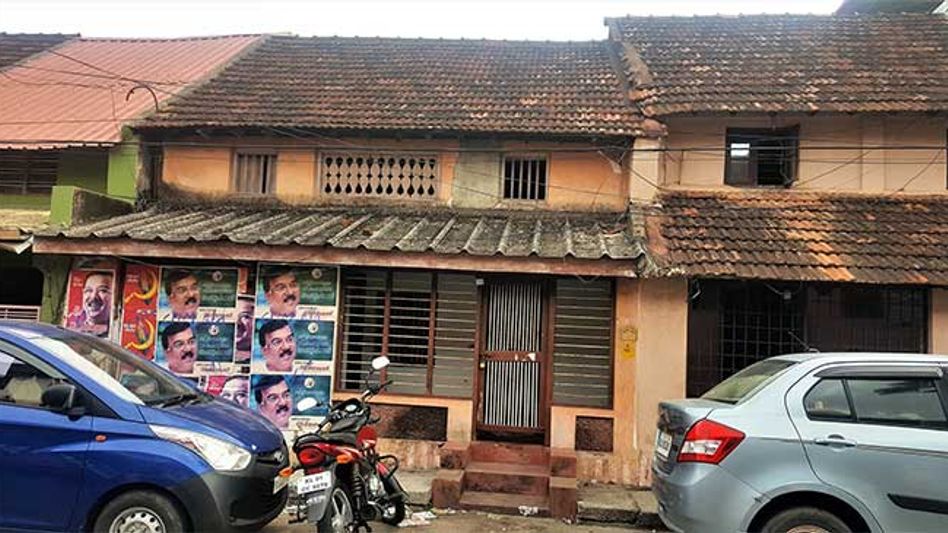Perspective | Within The Agraharam
 agraharam
agraharamBy: Bindu Vasumathy
My friend grumbled under her breath loudly in a mix of Malayalam and Tamil as she tried to dislodge a big piece of torn poster stuck beneath the wheels of a scooter that was parked right in front of her doorstep with a flimsy broom and a stout piece of stick..." Eppadi avarkal itai ceyya mudiyum enthoru kashtamaanithe..."
While she struggled with the recalcitrant piece of paper, I skimmed the street before me with a quick glance. The doorsteps appeared in a single line, neat piles arranged on either sides of the tarred road. In front of each one of them, upon the cemented ledge merging with the road still wet from a wash, there appeared the entwined pattern of a neat "kolam" in white. Every doorstep, save the one my friend was quite futilely trying to free of litter.
The scene was enacted before one of the linear homes in Valiyashala agraharam of Thiruvananthapuram, one of the largest enclaves of brahmin community living. My friend owned an ancestral home here in which three generations from her father's side of the family had lived peacefully. The last occupant was her brother who had finally locked the vertical sashed door of this home some thirty years back. He was a man, newly emerging from the dim chrysalis of its interiors, poised to take on the world after his quiet brooding phase within. The house since then, no longer a home, lay shrouded in darkness and damp.
The courtyard within, which was intended to brighten the dingy windowless rooms surrounding it developed the thick green cloak of a noxious invader whose stout roots piercing the crumbly laterite foundation seemed to sap the remaining living force out of that home. With sunlight cut off even during the fiercest summers, the house became the abode of mice, bats and even occasional snakes that wormed their way within through the fissures and cracks on the door jamb, from the garden space at the back of the house.
When the trains whistled past the railroads out of Trivandrum Central just beneath the boundary wall, the irregular clacking of their heavy wheels seemed to grip the fragile house in feeble dying tremors. The house would have slowly crumbled down, its property rights passing on uncontested to its real inheritors...the lower life forms. But it was not to be. My friend's grandfather's karmic vision, she believes, extends down his lineage still, like a dusty ray of light to touch upon this house and salvage it from ruin. In the past few months this house, once sunken into deep soporific slumber, was woken up sporadically, through brief visits from my friend and her two siblings.
My friend was very eloquent in explaining the merits of an agraharam home to me, a total stranger to the way of life behind sashed impuny doors. She says it’s a self thriving community. The people had very less needs that prompted them to step outside the enclave. Everything that was the hallmark of their frugal living style could be found within its bounds. The predominant among the needs was the space to turn to and offer their salutations to God and the next prominent, tangible element of the Universe, the sun.
The street at Valyashala that bore her home had a small Ganapathi temple created at the western end of the street, right in the middle of the road. You cannot miss him or ignore him if you pass by. The eastern end of the street was a long way off and provided an uncluttered view of the rising sun, which she assured me was as brilliant as its darshan over the Kanyakumari seas. The linear homes which shared two walls on either side with its neighbours offered safety even to single women and old couples living within.
A shout, scream or wail would easily float over the common walls and send its alert to the two neighbouring homes. Life flowed by peacefully each day like clockwork within the enclave,rising to the call of hawkers and vendors who came in with their push carts loaded with fresh greens and vegetables in the mornings, to the cries of men on bicycles shouting " malligaipoovae"in the afternoons and to the peals of tingly bells accompanying the arathi at the temple in the evenings. There emerged from these homes, men dressed for contemporary life who hurried to offices, children in uniforms going to schools and ladies hurrying off to work busily closing their handbags as they began their brisk walk down the street, but apart from these occasional jarring visuals, the street reverted back to its laidback ambience immediately, sleepy behind the ochre and white lined foundations with the "vathals" ," naranthinka" pickles drying on sunny doorsteps, guarded over by the mystic " arimaavu kolam".
I could see her point. But the analyst in me had to ponder. I looked beyond the present that let me an outsider spend few nights within its guarded walls, to an era when such enclaves were created. This migratory community whose exodus into Ananthapuri was triggered by the Travancore rulers of the past who "acquired" Brahmanical status and who had the need to surround themselves with these exotic brahmin protectors, by themselves needed protection from the local indigenous population.
Also Read: Why Right to Health as Fundamental Right?
The rulers ensured their protection in return by giving them free land in prime positions, close to their ruling deity, Sree Padmanabhaswamy, to construct their community living habitats. The innocuous-looking agraharams of today had all tales of superiority and superciliousness to regale from their past. The self-sufficiency my friend highlights and the unwarranted help one gets in times of need now were in the past marks of their aloofness from the common milieu and their clannishness. What might have been a necessity of the past, no longer exists. Is it then meritorious to be branded instantly along casteist lines by the mere revelation of one's living address? Somehow I found that thought a bit difficult to accept, whatever the undoubtful conveniences the enclaves offer even to date.
Maybe these thoughts p[rompted me to question my friend that morning..." If community living is good for the welfare of all, why should you now have the need to clean your doorstep off litter and garbage which someone in the vicinity is wilfully dumping upon your doorsteps? Why can't the owners of these two linear homes on either side of you, make an effort to find the perpetrators and warn them off? After all, this trash can easily drift across to mar their "kolams." Or why can't these people who block your entrance claiming it as their parking lot trying to pick up a broom and clear the litter once in a while?" My friend returned her blank stare that precludes the preoccupation of her mind. I was not sure she even heard me. Seizing the broom and stick from her arms, I purposefully tore down posters off the walls and slid the garbage within its rolls to pull it aside.
Our sojourn over and as I waited to flag down an autorickshaw to the railway station, just walkable distance away, I noticed the neat scrawl of my friend's hand upon the whitish gap on the front wall acceded by the torn posters..."Malinyam nikshaepikkaruthu." Seeing the line of my gaze, she asked me " Ithu pora allae?" I just nodded my head, a rueful smile playing upon my lips. When it comes to core people, behave in predictably similar ways...irrespective of their elevated caste, the colour of their skin, the rigidity of their belief in God or their near manic sense of projected cleanliness. The haven offered by community living is an eggshell-thin fragile myth...and one that definitely needs to invaded just like the alien plant that so wilfully encroached upon the interiors of her home.
Copyright©2025 Living Media India Limited. For reprint rights: Syndications Today









